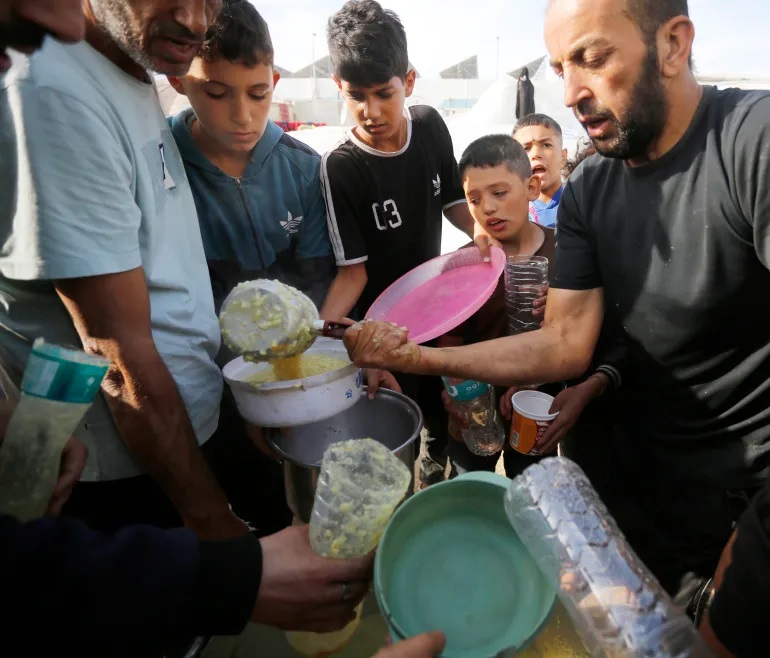Animal-Drawn Carts Replace Cars in Gaza Amid Fuel Blockade
With vehicles immobilized by Israel's siege, Gaza’s streets echo a return to pre-industrial transportation as residents rely on donkeys and horses to survive.

Watan-The streets of the Gaza Strip are currently devoid of cars, trucks, and buses of all sizes. The movement of people now relies entirely on walking or using animal-drawn carts, due to the severe blockade imposed by the occupation authorities since early March. These carts now have designated stops known to residents, and using them has become a common sight across all ages and social levels in the Strip.
The vast majority of Gaza residents who still own motorized vehicles—those that run on fuel or gas—have mostly stopped using them. These vehicles are now parked either beside homes or near displacement zones with only minimal fuel remaining, reserved for potential emergency evacuations. Most of these vehicles are now completely immobilized due to depleted fuel reserves.
The transportation crisis in Gaza has worsened because of the prolonged and intense siege that started in early March. Some residents with transport vehicles had been using part of their household gas allocations or even cooking oil as diesel alternatives. However, with the complete halt in the entry of these goods and their scarcity in the markets, vehicle owners who once charged high fees for transport have been forced to cease operations.
Residents now say that hearing the sound of engines on the roads, once a normal part of life, is a thing of the past—even on main roads connecting vital parts of the Strip. They have been replaced by carts pulled by donkeys or horses, in a scene reminiscent of life more than 50 years ago.

A Primitive Transport Fleet
Riding animal-drawn carts has become routine for all Gazans. Even young women, previously unfamiliar with this mode of transport, as well as young men, employees, and merchants of all classes, now use these carts as a forced alternative, especially for long-distance travel or during forced displacement.
At the edge of the Nuseirat refugee camp market in central Gaza, a young woman in her twenties stood beside a horse-drawn cart heading west toward her home. She stepped onto a wooden plank used by the cart driver, then turned and sat atop the wooden cart mounted on four wheels. Alongside her were three other young women, two elderly women, and a man appearing to be in his mid-fifties—each carrying items they had purchased from the market.
Before boarding, 62-year-old Intisar Zayed explained that she had walked from the northern edge of the camp to do some shopping. Unable to carry her purchases all the way back on foot, she decided to take the horse-drawn cart. “It’s been a long time since we rode in a car,” she said, pointing to a space that once served as a parking lot—now taken over by food vendors. “As you can see, there are no cars anymore.”
She reminisced about decades past when animal-drawn carts were the norm in Gaza and said, “This is how it used to be, and now we’re back to it.”
Severe Displacement Conditions
The halt of cars and trucks, especially after the resumption of Israeli aggression, has left Gaza’s residents in dire circumstances. Many families were forced to flee areas of ground military operations, walking over 20 kilometers on foot, carrying only small amounts of belongings and food. Some even carried their children and elderly relatives.
This was the case for Mahmoud Abdel Al from Rafah, who relocated with his family to the Al-Mawasi area in Khan Younis. Due to the scarcity of animal-drawn carts, most people walked the entire distance under harsh conditions. He noted that the cost of using these carts has increased significantly. Now, living in western Khan Younis, he must either walk for nearby errands or use a cart for longer journeys. Sometimes, he even travels with his wife on these carts—something he had never done before in his life.

Designated Cart Stops
In densely populated Khan Younis—especially with the influx of displaced people—specific stops for animal-drawn carts exist at the central market, on the eastern town entrances, and in western displacement areas. These carts mostly operate between the city center and the area around Nasser Hospital.
In the Nuseirat refugee camp, young men with such carts stand in the middle of the central market, calling out to passengers headed toward places like Al-Zawaida, Deir al-Balah (home to the main hospital), or the nearby Bureij camp. They work until sunset and nightfall.
Abu Ghassan, a man in his fifties who owns a horse-drawn cart and waits for his turn near Nuseirat market, said he transports dozens of people daily—including workers, doctors, teachers, women, and children—for a fee that helps him get by. Previously, he used his cart for moving furniture, heavy appliances, or goods for residents and merchants. The war has forced him to work as a passenger transport driver.
He noted that no one feels embarrassed anymore about riding animal-drawn carts, adding, “Everyone rides the kara now,” using the local slang for these carts.
Even Fuel Wouldn’t Fix It
Even if fuel were allowed into Gaza, it wouldn’t solve the crisis. The occupation authorities only permit limited amounts of fuel and require it to be used exclusively for UN organizations and public facilities like hospitals and municipal services—not for civilian use.

No Feed for Animals
Cart owners are now struggling to feed their animals due to a lack of barley, which is sold at high prices, as well as dried bread and spoiled vegetables from the markets. Because food is scarce, families no longer waste leftover bread. All leafy greens, even the yellowed parts once discarded or fed to animals, are now consumed by people. Wild winter herbs that grow in vacant lands are also disappearing with rising temperatures and lack of rain, expected to vanish entirely in the coming weeks—making it harder to find animal feed.
One cart owner said his donkey can no longer pull heavy loads as before, having lost much of its weight and muscle strength.
Municipal Services on the Brink
Gaza’s municipalities have warned that their service vehicles are close to halting operations due to a lack of fuel. They have been operating at minimal capacity during the fuel crisis and now say they are nearing a total shutdown of humanitarian services.






